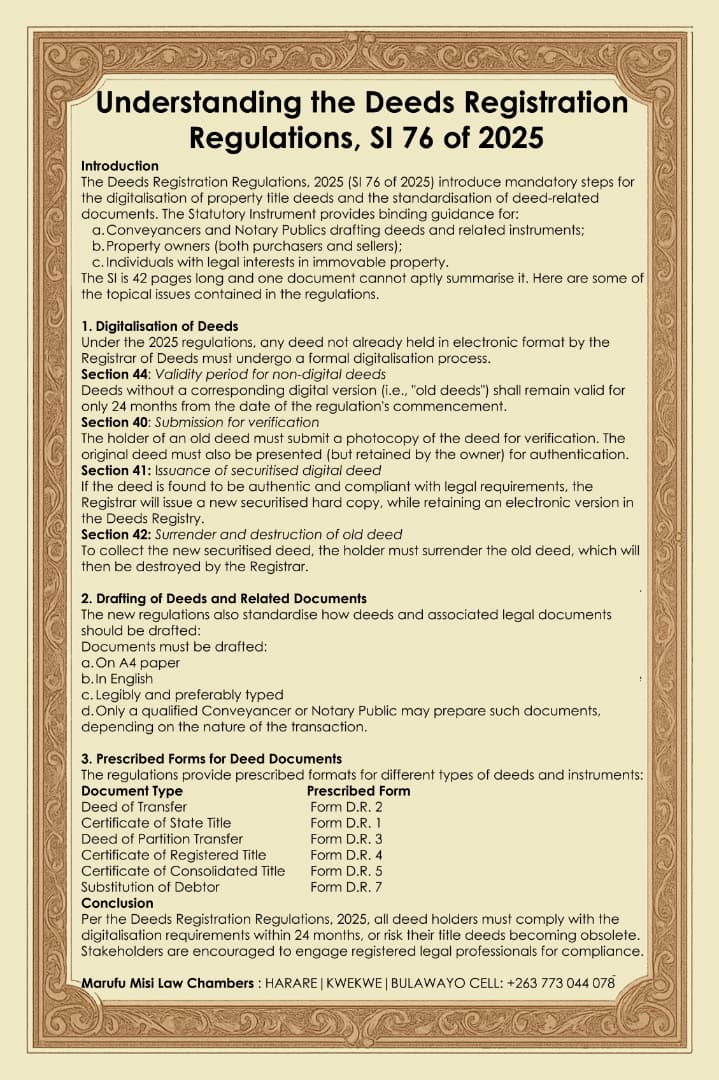Farmer–Miner Disputes in Zimbabwe: A Legal Perspective
Farmer–Miner Disputes in Zimbabwe: A Legal Perspective
Introduction
In Zimbabwe, disputes frequently arise between farmers who hold surface land
rights and miners who hold sub-surface mineral rights. Farmers derive their rights
primarily through valid offer letters issued by the Ministry of Lands, Agriculture,
Fisheries, Water and Rural Development, while mineral rights are governed
under the Mines and Minerals Act [Chapter 21:05]. The collision of these two
legal regimes has generated persistent conflict, with tensions centering on
whether agricultural or mining activities should take precedence when the two
overlap.
The Common Law Position
Before the enactment of the Mines and Minerals Act in 1961, mining activities
were regulated largely through common law principles. Under common law,
there was little or no uncertainty as to which rights prevailed because ownership
of land extended both to the surface and everything beneath it. The seminal
authority on this principle is Union Government v Marais 1920 AD, in which the
court held that “the owner of the land is not only the owner of the surface mine
and mineral but everything that is adequate to it, that is, from the surface of
land down to hell and to heavens.” Thus, land ownership inherently included
both surface and mineral rights, minimizing the potential for farmer–miner
disputes.
The Mines and Minerals Act (1961) and the Shift in Ownership
The position changed fundamentally with the enactment of the Mines and
Minerals Act in 1961. Section 2 of the Act provides that:
“The dominium in and the right of searching and mining for and disposing
of all minerals, mineral oils and natural gases, notwithstanding the
dominium or right which any person may possess in and to the soil on or
under which such minerals, mineral oils and natural gases are found or
situated, is vested in the President, subject to this Act.”This provision effectively transferred all mineral rights from landowners to the State. Consequently, ownership of the surface land no longer conferred ownership of the minerals beneath it. This principle was reinforced in Minister of Mineral Resources & Others v Sishen Iron Ore Company (Pty) Ltd & Another
ZACC 45 [2013], where the court emphasized the State’s ultimate authority over
mineral resources. This shift gave rise to the now familiar farmer–miner disputes.
Judicial Interpretation of Section 179
Where disputes arise, section 179 of the Mines and Minerals Act provides clear
guidance by establishing the primacy of mining rights. It stipulates that:
“Subject to subsection (12) of section one hundred and eighty, the owner
or the occupier of land on which a registered mining location is situated
shall retain the right to graze stock upon or cultivate the surface of such
location in so far as such grazing or cultivation does not interfere with the
proper working of the location for mining purposes.”
In practice, this means that while farmers may continue to utilize the land for
agricultural purposes, their rights are limited to the extent that they do not
obstruct mining operations. The courts have consistently upheld this
interpretation. In Satond Investments (Pvt) Ltd v Munashe Shava HH 336-18, the
court held that section 179 “gives a landowner lesser rights than the miner’s
rights. In other words, the miner’s rights are superior to the farmer’s rights. Thus,
where two competing rights on a piece of land exist, one of a miner and one of
a farmer, the farmer’s rights are subordinate or should accede to the miner’s
rights.” Similarly, in Tirivangani Chidyausiku v Havilahvale Mining Syndicate & 3
Ors HH 314-23, the court reaffirmed the supremacy of mining rights over surface
agricultural use.
Prospective Reforms under the Mines and Minerals Bill (2025)
Despite the current legal framework, conflicts continue to surface, highlighting
the inadequacy of the Act in balancing the interests of farmers and miners. To
address these challenges, the new Mines and Minerals Bill, gazetted on 25 June
2025, introduces substantial reforms to Zimbabwe’s mining sector. Notably, the
Bill seeks to provide clearer mechanisms for resolving disputes between
landowners and miners. Section 36 sets out principles for balancing competing
interests, while Part X establishes dispute resolution frameworks designed toreduce the dominance of mining rights and better protect landowners’ and
farmers’ interests.
Conclusion
Farmer–miner disputes in Zimbabwe stem from the fundamental shift in
ownership of mineral rights under the Mines and Minerals Act of 1961, which
vested all sub-surface minerals in the State while relegating surface rights to
secondary status. Judicial interpretation has consistently upheld the supremacy
of mining rights over farming rights, as codified in section 179 of the Act.
However, the introduction of the Mines and Minerals Bill (2025) signals a possible
recalibration of this balance, offering the prospect of fairer dispute resolution
mechanisms. Whether these reforms will sufficiently address longstanding
tensions remains to be seen.
Compiled by: Alpha Kiyidzendenga Karembera







